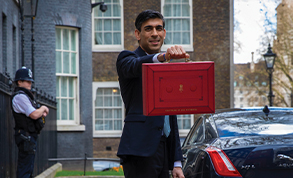Spending review confirms increase in NHS funding
The additional £3bn, trailed ahead of the spending review announcement, is part of £20.3bn for the Department of Health and Social Care overall to support the continuing response to Covid-19, building on the £50.1bn made available in 2020/21.
The rest of the 2021/22 Covid budget includes £15bn for Test and Trace, £2.1bn for personal protective equipment and £163m for medicines and therapeutics. Further funding is being made available for vaccines, adding to the more than £6bn that government has already allocated to develop and procure vaccines.
The Department’s core resources will receive a cash increase of £6.6bn (£6.3bn for NHS England) compared with the current year. The Treasury said that the settlement of £147.1bn represented an average 3.5% real-terms increase per year since 2019/20.
The department’s core capital budget has been set at £9.4bn – £2.3bn above pre-Covid levels in 2019/20 – a 13.4% average real-terms increase per year.
In total the core departmental expenditure limit (resource and capital) will be £156.4bn, which represents average 4% growth over the last two years in real terms.
Unveiling the spending review in the House of Commons, chancellor Rishi Sunak (pictured) underlined the difficult balance between spending and borrowing that needed to be navigated during the Covid-19 pandemic. ‘Our health emergency is not yet over,’ he said. ‘And our economic emergency has only just begun. So our immediate priority is to protect people’s lives and livelihoods. But today’s spending review also delivers stronger public services. Paying for new hospitals, better schools and safer streets. And it delivers a once-in-a-generation investment in infrastructure.’
The additional £3bn for the NHS includes £1bn to help tackle the elective backlog. There are more than four million patients on the elective care waiting list with nearly 140,000 waiting more than a year, the highest level since 2008. And there are concerns about a hidden backlog, with massive reductions in the numbers of people referred for care during Covid. The Treasury said the extra funding would enable hospitals to carry out up to one million extra checks, scans and additional operations.
Another £500m will be used to address waiting times for mental health services, with the remaining £1.5bn easing existing pressures in the NHS caused by Covid.
The spending review also gave further detail of how the previously announced £3.7bn of funding to support the Health Infrastructure Plan will be phased over the coming four years, with £0.6bn of funding in 2021/22 rising to £1.7bn in 2024/25. Alongside this programme, which aims to build 40 hospitals by 2030, A further £1.7bn will support the upgrade of over 70 hospitals, with £0.7bn next year falling to £0.2bn in 2024/25.
Operational capital investment in 2021/22 has been set at £4.2bn to support maintenance and refurbishment of hospital infrastructure, while a further £165m is being ringfenced to replace outdated mental health dormitories with single en-suite rooms.
The settlement also includes £260m for Health Education England to support the training of more doctors and nurses and address commitments in the NHS long-term plan.
The downgrading of the spending review to a single year put paid to any ideas of a long-term funding package for social care being announced. However, the government said that local authorities would have access to over £1bn of spending for social care through a £300m social care grant and the ability to levy a 3% adult social care precept. This funding is on top of the £1bn social care grant announced last year, which is being maintained.
Nuffield Trust chief economist John Appleby said the £3bn recovery package was welcome, but it was not clear if it would be adequate to meet the challenge ahead. ‘Waiting lists will continue to grow as hospitals continue with time consuming infection prevention and control measures, which significantly reduce the rate at which patients can be seen and treated. That will create real pressure, requiring extra staff and capacity, which will need to be fully funded if the NHS isn’t going to spend the next decade running to catch up,’ he said.
Professor Appleby added that the promised increase in NHS pay would also be appreciated. ‘[But] without a similar commitment for social care there is a real risk the vulnerable sector will see its much-needed workforce go elsewhere.’ And he questioned whether councils would really have access to much of the apparent increase in social care funding as it would have to be raised locally through taxes, which would be difficult in poorer areas.
On pay, Mr Sunak, said he could not justify a significant, across the board pay increase for all public sector workers. Private sector workers had lost jobs, been furloughed, seen wages cut and hours reduced – the public sector had not, he added. However, he would take account of the pay review bodies advice in providing a pay rise to over a million nurses, doctors and others working in the NHS. And while other public sector pay rises would be paused, there would be protection for those on lower incomes. The 2.1 million public sector workers earning below the median wage of £24,000 will be guaranteed an increase of at least £250.
Related content
We are excited to bring you a fun packed Eastern Branch Conference in 2025 over three days.
This event is for those that will benefit from an overview of costing in the NHS or those new to costing and will cover why we cost and the processes.